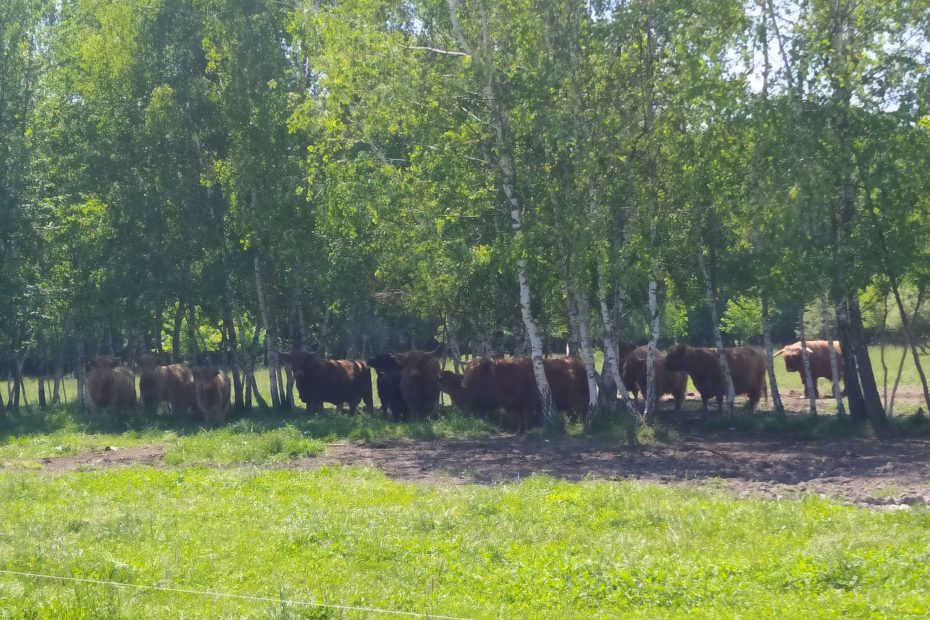A training meeting as part of the “Demonstrations” project at a farm keeping Red Angus and Highlander beef cattle in Kamienica Polska (Śląskie Voivodeship).
On 31 May this year, a group of twenty students from an agricultural technical school in Żarnowiec, Śląskie Voivodeship, visited the farm of Joanna Kubara, managed by Roman Walenta and located in Kamienica Polska near Częstochowa. The farm is involved in a project to set up demonstration farms, covered by sub-measure 1.2 “Support for demonstration projects and information activities” of the Rural Development Programme 2014–2020, under which demonstrations on “Modern technologies for breeding and raising beef cattle” are being carried out. This operation is co-financed by the European Union with funds from the European Agricultural Fund for Rural Development (EAFRD).
The direct contractors of the project are the National Research Institute of Animal Production and the voivodeship Agricultural Advisory Centres, in this case the Małopolska Agricultural Advisory Centre in Karniowice. Together with the Agricultural Advisory Centre in Brwinów, the above-mentioned centres have formed a consortium to implement this project.
The theme of the on-farm demonstration is “Using innovative technologies in beef production based on the example of extensive cattle breeding”. It is one part of a series of demonstrations aimed at creating model farms equipped with innovative equipment to support precise and safe animal handling. The farm specializes in extensive breeding of the rare Red Angus and Highland cattle breeds in Poland and operates as an organic farm. During the first visit, the participants were shown around the livestock buildings, the pastures and infrastructure were presented, the characteristics of the herd and the equipment of the machinery stock were discussed in detail.
The farm covers about 56 ha of grassland, of which 54 ha are in LFA zone I and 2 ha in LFA zone II. Each paddock is electrically fenced and drinkers are connected to a well. From April to November the animals are on pasture 24 hours a day. During the winter season, the animals are housed in a spacious, well-ventilated barn. On bedding there is one barn for cows with calves and two overhead shelters for heifers, young stock and fattening cows. The herd comprises approximately 84 purebred animals, most of which are under meat performance testing by the Polish Association of Beef Cattle Breeders and Producers. The cows present in the herd are characterized by their longevity, and the culling rate is low, mainly due to random cases or age-related sterility. Animals of both breeds kept in the herd are resistant to adverse environmental conditions. They are also long-lived and well adapted to feeding conditions in an extensive system.
The herd on the farm is fed exclusively on roughage. In summer the animals have access to pasture and in winter they are fed haylage and meadow hay. The farmer’s good practices also include the use of wooded pastures, which the animals use in hot weather, rotational use of meadows and pastures, providing excellent welfare conditions and counteracting heat stress. In addition, newborn calves are monitored for hygiene and health status.
The on-farm demonstration aims to show rational pasture management in the context of periodic droughts and feed shortages. The owner of the farm sets himself the task of developing innovative methods and tools to help handle the animals accurately and safely. The demonstration plans to purchase and equip the farm with modern equipment, including a restraining chute with livestock scales, a system of electric and portable mobile (rolling) fences to separate smaller spaces in the grazing paddocks, an isolated drinker designed for a newly built barn or pasture, and a microchip system to monitor animal body temperature and movement in both the buildings and pastures.
Bartosz Szymik, Ph.D. Eng. from the Department of Cattle Breeding at the National Research Institute of Animal Production, provided the meeting participants with details of the purpose of the demonstration and its scope. He emphasized the importance of water retention in permanent grassland and the need to measure pasture productivity. Together with the farm supervisor on behalf of the Agricultural Advisory Centre in Częstochowa, Olga Susek, he also conducted the stationary part of the lectures, which took place after a coffee and cake break on the farm. During the lectures, participants in the first demonstration and training meeting learned about the characteristics of individual cattle breeds, their predispositions for production, nutritional requirements, beef cattle maintenance systems, herd management programmes and the principles of safe work and animal handling. The breeders actively discussed the reproduction of their animals, mating dates, commercial crossbreeding and calf rearing. The training ended with a joint lunch.
